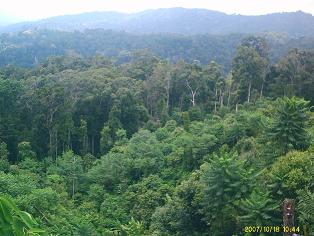|
RAIN FOREST

|
Rain forest is a woodland of tall trees growing in a region of year-round warmth and abundant rainfall. Almost all rain forests lie at or near the equator. They form an evergreen belt of lush vegetation that encircles the planet. German botanist Andreas F. W. Schimper first coined the term rain forest-in German, Regenwald-in 1898.
Tropical rain forests occupy only 6 to 7 percent of the earth's surface. However, they support more than half of the world's plant and animal species (kinds). More kinds of frogs and other amphibians, birds, insects, mammals, and reptiles live in rain forests than in any other area. Scientists believe millions more rain forest species remain undiscovered.
|
The rain forest provides people with many benefits. Its plants produce timber, foods, medicines, and such industrial products as dyes, fibers, gums, oils, and resins. Rain forests help regulate the earth's climate and maintain clean air. The forests' lush, green beauty and rich wildlife offer a special source of enjoyment.
In addition, rain forests provide homes to millions of people. Such groups as the Yanomami of South America, the Dayaks of Southeast Asia, and the Pygmies of central Africa have lived in rain forests for centuries. They make their living by hunting, fishing, collecting forest products, and farming. Traditional forest peoples have acquired much knowledge about the rain forest's plants and animals.
In spite of these benefits, people cut down thousands of square miles or square kilometers of rain forest each year. This destruction eliminates thousands of species of animals. A number of governments and conservation organizations are working to preserve the rain forests.
Characteristics of rain forests
Climate and soil. The temperature in a tropical rain forest varies little. It rarely rises above 95 °F (35 °C) or drops below 64 °F (18 °C). In many regions, the average temperature in the hottest month is only 2 to 5 Fahrenheit degrees (1 to 3 Celsius degrees) higher than the average temperature in the coldest month. Most rain forests receive more than 80 inches (203 centimeters) of rain annually. Some areas may receive more than 250 inches (635 centimeters) of rain each year. Thundershowers can occur more than 200 days a year.
Rain forest soils vary greatly from place to place. In many areas, the soil is acidic and infertile because years of heavy rains have washed out most of the nutrients (nourishing substances). Most rain forest nutrients are part of living plants. Small amounts of nutrients occur in a thin layer of topsoil that contains decaying vegetation.
Rain forest trees have developed several ways of capturing nutrients. For example, they obtain nourishment from rainwater that collects in their leaves or along their trunks and branches. They also withdraw nutrients from their old leaves before they shed them. The roots of most rain forest trees grow close to the surface and quickly absorb soil nutrients before they wash away. Special fungi called mycorrhizae grow in or on many of the roots and help them absorb minerals from the soil.
Structure and growth. Rain forests grow in four major layers: (1) the canopy, or top layer; (2) the sub-canopy, a layer of trees just below the canopy; (3) the understory, a shady lower area; and (4) the floor. The tallest trees, known as emergents, grow more than 165 feet (50 meters) tall. The crowns (tops) of these trees dominate the canopy. Emergents receive the greatest amount of sunlight, but they must endure high temperatures and strong winds. The crowns of other trees in the canopy usually form a nearly continuous covering of leaves 65 to 165 feet (20 to 50 meters) above the ground. Some tall trees have large growths called buttresses that extend from the base of the trunk and help support the tree.

More than 70 percent of rain forest animal and plant species reside in the canopy and sub-canopy. Many tree branches have a dense covering of epiphytes, plants that grow on other plants and obtain nourishment from the air and rain. Vines called lianas often climb on or around the trunks and branches of trees.
The shady understory shelters small palms, young trees, and herbaceous (nonwoody) plants that can grow in dim light. Many popular house plants, such as philodendrons, dieffenbachia, and ferns, are developed from species that live in this area. Some scientists believe only 1 percent of the sunlight available to emergent trees reaches the understory.
A thin layer of fallen leaves, seeds, fruits, and branches covers the forest floor. This layer quickly decomposes and is constantly replaced.
The layers of a rain forest continually change. Large old trees die and fall to the ground, leaving a gap in the canopy. Direct sunlight penetrates through to the understory and stimulates the growth of seedlings, saplings, and small trees below. The small trees slowly stretch upward into the canopy. As they branch and expand their crowns, they fill the gaps in the canopy. A mature rain forest consists of a mixture of closed canopies, gaps, and patches of growing trees where the canopy is being rebuilt. The regeneration of many rain forest trees depends on gaps developing regularly in the canopy.
Plants and animals. About 45 percent of the world's plant species occur in tropical rain forests. Scientists have counted over 250 species of trees in small areas of Asian and South American rain forests. A similar plot of land in a northern temperate forest would have only about 10 to 15 tree species. In addition to trees, rain forests support a great variety of bamboos, herbs, and shrubs. Climbing vines, ferns, mosses, and orchids grow directly on the trunks and branches of large trees.

Because of continual moisture and warmth, tropical rain forests stay green all year. Most rain forest trees continually lose old leaves and grow new ones. Only a few species lose all of their leaves for a brief period.
|
Fish, amphibians, reptiles, birds, and mammals abound in the rain forest and its rivers. However, insects rank as the most plentiful rain forest animals. An individual tree in a South American rain forest may support more than 40 species of ants. Scientists have counted about 1,200 species of beetles living in only 19 tree crowns from Panama.
Plants and animals in the rain forest depend on one another for survival. Many animal groups, especially insects and birds, pollinate the flowers of rain forest trees. Such animals receive food from the flowers' nectar. In return, they pollinate the next flowers they visit. Some trees rely on only one species of insect for pollination. Many rain forest trees also depend on animals to disperse their seeds. In the Amazon rain forest, fish disperse the seeds of some trees.
Next >>> |
Contributor:
Charles M. Peters, Ph.D., Kate E. Tode Curator of Botany, The New York Botanical Garden.
..
|
|



